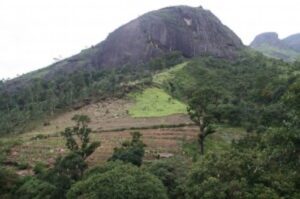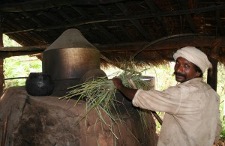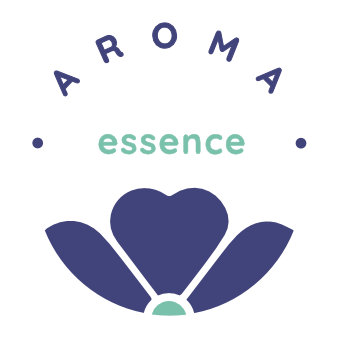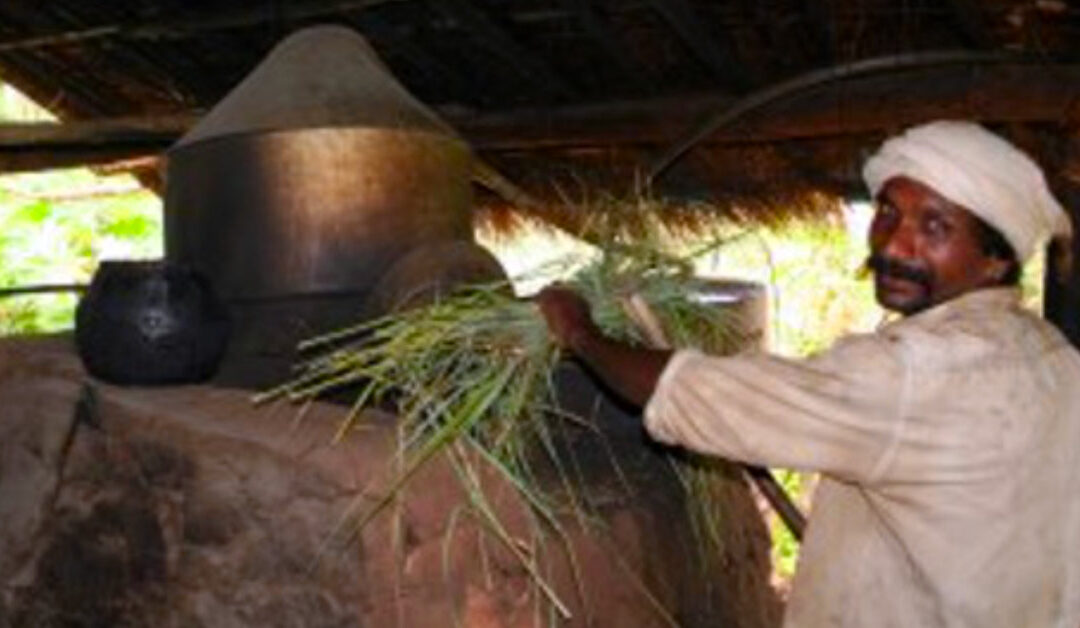
Lemongrass field in Elephant Mountains
During my search for sandalwood forest in Western Ghats (Kerala) I came across intriguing morsel of information about the area. An old Polish saying warns that ‘curiosity is a first step towards hell’ by mine led me on a rather steep trek into the Elephant Mountains, high above the sandalwood forests. Led by a guide who could not speak any English (or Polish, for that matter) I made my rather slow and breathless way to a tiny tribal colony perched well above 4500 feet above the sea level. Beyond a cluster of small mud and straw huts I could see women from the Indian tribe of Mutuvans tending to… lemongrass fields. It was difficult to believe that lemongrass, usually associated with Thai cuisine, could grow so happily here. 65 varieties of spices – from hot chillies, pepper to vanilla – are grown in India, and this high number makes it a truly unique country. But lemongrass is not grown for the culinary use…
My journey started in old Fort Cochin, the charming port town in Kerala, South India. The city, now known as Kochi, has a distinctive character. This romantic historic town immediately takes the visitor back in time. It is not difficult to imagine that once upon a time this maze of labyrinthine alleys and roads, colonial mansions and peeling godowns was a centre of the international spice trade, stomping ground of merchants and traders from China to Arabia.
According to Sumerian Records Kerala was a major spice exporter as early as 3,000 BCE. Ancient records show that King Solomon valued spices from the area. The writings of ancient Greek historian, Herodotus, also indicate that the Greeks enjoyed spices in their cooking – he mentions the spice trade with Kerala in… 500 BC!
The discovery of the new sea route from Europe to Calicut (now Kozhikode) in India by Vasco da Gama (15th century) opened a new chapter in the history of Kerala. The arrival of the Portuguese was followed by the Dutch, British and the French. The colonial conquerors all had one interest in common – spices, especially black pepper.
1,100,000 tonnes of spices are produced in India every year – that is 70 % of the world spice production. Kerala produces 97% of national crop of black pepper! But the state is also renowned for… lemongrass essential oil, popularly known within the world trade as ‘Cochin oil’. This term comes from the fact that more than 90% of this oil is shipped from Cochin port. The annual world production of lemongrass oil is around 1000 t from an area of 16000 ha. In India, it is cultivated in about 4000 ha and the annual production is around 250 t. Impressed by the statistics I imagined factories with attached warehouses, high tech stainless steel stills, computerised processing and many chemists in white lab coats. What I discovered could not have been farther from it…

Muthuvan settlement
Sometime in 16th century, during the collapse of Panyan kingdom a tribe of cultivators from the plains of Madurai – Muthuvans – took refuge in the forests of the Elephant and Cardamom hills of Western Ghats. In the jungle habitat, they set up small remote colonies and took up shifting cultivation as the primary mode of subsistence and continued it for generations. About 40 years ago, a large part of their habitat was declared a Protected Area and Muthuvans were pressurised by the Forest Department to give up shifting cultivation and to vacate the forest. In order to avoid eviction and to continue to live in their ancestral places they negotiated with the Forest Department to take up cardamom cultivation under the tree cover as a primary source of income. Similarly in another area, the remaining Muthuvans took up cultivation and distillation of lemon grass oil as a main source of income.
‘Tribals’ or indigenous people make up 8% of the population of India – that is approximately 70 million people. 24000 are Muthuvans. Lemongrass essential oil is produced in 20 out of 91 Muthuvan settlements scattered throughout the mountains in Idukki district in the state of Kerala.
Meeting the tribe
I was very lucky to be granted access to the tribe. They are well known for their independence and lack of trust in the civilized world. They have their own medical system and preserved their intriguing culture. Not only do they not partake in education but even refuse to connect with other tribes. I did not know what to expect…

On the way to meet the tribe…
It was hot. There was no road, just a steep and stony path winding through a lush botanical heaven. There was no way of finding out how long we will need to march for. But the guide did take a good care of us by feeding us freshly picked wild mangos rinsed in a mountain stream. Finally the area flattened a bit and the habitat changed. We were at 4500ft above the sea level! I recognised bright green grassy clumps as lemongrass. We were close…
We entered the settlement of surprisingly neatly arranged rectangular mud and straw huts, the slope so steep that the village was terraced. Established 70 years ago the colony housed 40 families. Immediately to the left there was a larger building, which as I later realised, was a dormitory for unmarried men (above ten years of age). Right at the front there was a village hall. We were welcomed by few smiling men and served the most delicious black tea in gleaming stainless steel cups. Even some ‘sarkkara’ (jaggery) was provided. I was surprised to see a small solar panel on top of each hut. ‘One bulb!’ someone explained as they led us into the village hall where in the corner, protected by the cardboard box, stood….a television set connected to a few car batteries!
Not surprisingly women kept their distance. They are strictly prohibited to have contact with anyone outside their clan or other people, especially other men.
High above the village, on a steep slope, we could see small figures of women tending to a green lemongrass field. I did wonder how anything could grow there…
Cultivating lemongrass
Lemongrass can be grown in almost all types of land available – from very light and sandy soil to upland laterites. In fact, it not only requires very little soil but it also binds it with its root system – very much like its cousin, vetiver – preventing soil erosion so common in India due to its two monsoon seasons. Acidity and alkalinity of soil have very little impact on lemongrass. The plant however, does not tolerate shady conditions and oil yield is drastically reduced when the crop is grown under diffused light. Quality of the essential oil however is not affected by soil moisture regimes.
Once Forest Department demarcated the area to be used by the colony, Muthuvans divided the land among themselves – each family acquired the maximum area of land it required, depending on the number of working hands available in that family. The seeds of lemongrass were sown by the ‘broad-cast’ method, and the fields tilled with hoes to mix the seeds with the soil.
Lemongrass seeds have a dormancy of a few weeks and they lose viability in a few months. The seeds collected in January and February are usually sown in June. Germination is very poor if sown later than October. Seeds germinate in 5-7 days and the first harvest can take place 5 months later. Fields require almost constant weeding. Depending on climate and location lemongrass fields last for a maximum of 6-7 years and the grass is cut every 45 days throughout this period. The best harvest is achieved between the second to fourth years.
Muthuvans devised a very clever way of managing their fields. Every family divides the field it owns into four or five parts. They harvest one part at the time. As it takes the family 5 to 6 days to cut the grass from one part by the time the last part of the field is harvested, the first part of their field again becomes ready for harvest.
Distillation of the lemongrass essential oil

Loading the still
Distillation huts are set up close or within the lemongrass fields. The grass is cut 3 – 10 inches above the ground to avoid cutting immature leaves. Not only it helps the plant to regrow but essential oil from immature leaves contains less aldehydes and the yield is much lower.
The grass is either processed immediately or the next day. Allowing the grass to wilt for 24 hours will reduce the moisture (by about 30%) and therefore fuel consumption will go down and the oil quality will be higher. Chopping the grass a bit first allows loading more into the still in ‘one go’ and the production of oil is higher by 10%. This also helps save some fuel.
The extraction unit is a very simple directly fired ‘boiler still’ sitting in a stone and clay hearth. A coiled condensation pipe runs through a metal drum cooled by water diverted from the stream. There are no gauges, no specialist equipment, not even a thermometer! The hydrolate and essential oil drip into a small open container and then the oil is skimmed by hand with a ladle. The oil is then sold to traders who visit the settlement once a week.

Muthuvan child
The process is repeated almost whole year round.
Spent grass can be used as a mulch to prevent weed growth, especially after monsoon.
One acre of lemongrass
So how profitable is lemongrass cultivation?
Three bundles of grass of 25 kg provide half-a-kilogram of oil. It takes a Muthuvan family a week to cut, carry and distil 2 to 5 litres of lemongrass essential oil.
About 20 kg of seeds is needed for one acre of land. 1kg of seeds costs Rs.60 (£0.80).
From an acre, 30-40kg lemongrass oil can be extracted in a year and the price for it varies between Rs.350 and Rs.400 (£4.5 – £5.5) per kg.
You do the maths!
Lemongrass oil:
In India known as:
Sanskrit: ‘Bhustarah’
Hindi: ‘Gandhatran’
Malayalam: ‘Injippullu’
Tamil: ‘ Vasanapullu’
Kannada: ‘Majjigehallu’
Telugu: ‘Nimmagaddi’
Botanical family: Poaceae (grass family)
Genius: Cymbopogon (55 species)
Species (binomial names):
- Cymbopogon fexuosus (Nees ex Steud.) Will.Watson – often referred to as East Indian, Cochin or Malabar grass.
- Cymbopogon citratus (DC.) Stapf – often referred to as West-Indian lemon grass
Varieties: many
Area of origin: South Asia, Malaysia, India, Thailand
The oil:
When fresh the oil is yellow to dark yellow or dark amber in colour, turning red on prolonged storage.
Chemical constituents:
Aldehydes add up to 75-85% – consisting largely of geranial and neral (isomers of ‘citral’) – geranial around 47%, naral around 30% and citronellal 0.37% Geranial has a strong lemon aroma. Neral’s lemon aroma is less intense, but sweeter. Citronellal has an intensive citrus-like aroma but seems to be less sweet and fruity than citral.
The other constituents reported in lemongrass oil include (Husain et al, 1988) & (Lawrence 1989):
- hydrocarbons: alpha-pinene (0.24%), limonene (2.42%), caryophyllene, beta- pinene, beta- thujene, myrcene (0.46%), beta- ocimene (0.06%), terpenolene (0.05%)
- alcohols: linalool (1.34%), geraniol (5.00%), citronellol, nerol (2.20%), beta-terpineol (0.24%)
- oxides: 1,8 cineole (0-3%), caryophyllene oxide (0-2%)
- esters: linalyl acetate, geranyl acetate (1.95%)
- ketones: 6-methyl-5- hepten-2-one (1.50%)
Differentiation of lemongrass oils into West Indian and East Indian in trade has no major geographical significance as oils from both species are produced in both areas. However, the West Indian oil has less ‘citral’ and more myrcene than the East Indian oil. Although both oils have a pronounced fresh lemony fragrance, the odour of East Indian is stronger and it is considered fresher, lighter and sweeter.
Did you know?
- Lemongrass oil is used as a pesticide and preservative – the Oriental Research Institute Mysore, the French Institute of Pondicherry, and many other manuscript collections in India use it to preserve the ancient palm-leaf manuscripts. The oil helps prevent the palm leaves from becoming brittle and due to its hydrophobic nature it keeps the manuscripts dry so that the texts are not lost to decay caused by humidity.
- Lemongrass oil is used extensively in Ayurvedic medicine to help with relieving cough and nasal congestion.
- In Kerala, lemon grass is steeped as an herbal tea called “Chukku Kaapi”, literally “dried ginger coffee” and the oil is drunk in tea.
- It is mainly produced and used as a source of ‘citral’ – that is a mix of 2 isomers geranial and neral – needed as a starting material for the synthesis of a number of industrially important products.

